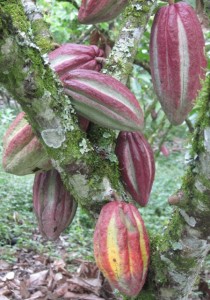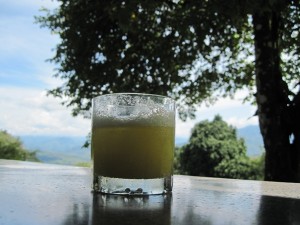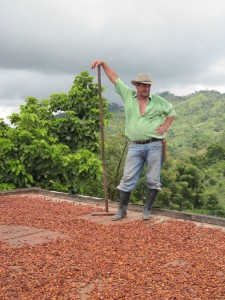Field Trip: Visiting Colombia’s Cordillera Chocolate Growers
Last fall I had the pleasure of traveling to beautiful Colombia to visit the birthplace of the delicious Fair Trade Certified™ Cordillera chocolate with which Bon Appétit Management Company chefs bake. Read this post to learn about the farm where the path to a chocolate bar starts. To read the socially responsible aspect to Fair Trade chocolate production, check out my third post.
Chocolate is such an integral part of American culture, and I too believe that little in this world can beat a bite of really fantastic chocolate. Well, I’m happy to report that getting to see where chocolate comes from, and learning all about how it’s grown and processed, actually gave consuming the finished product a run for its money.
In October I had the immense pleasure of traveling to central Colombia to visit the birthplace of the delicious Fair Trade Certified™ Cordillera chocolate with which Bon Appétit Management Company chefs bake. One of many products of the Compañía Nacional de Chocolates (CNC), Cordillera is named for the three different cordilleras, or mountain ranges, that make up the Andes Mountains in Colombia where the cacao grows. Cordillera chocolate is the first Fair Trade Certified™ “single origin” chocolate — the cacao beans are grown, processed, and manufactured into a finished product all from within Colombia. This gives the CNC greater control of their product, and it also means the group has been certified as having achieved a high level of social responsibility in which it gives back to the communities that grow the cacao.
I spent five days in Colombia learning about how Cordillera gets from the trees to the form in which Bon Appétit uses it. I toured the factory in Rionegra, the biggest chocolate factory in Colombia, visited three different demonstrative farms in the Santander region outside of Bucaramanga, and visited a research center outside of Tamesis (about 70 kilometers from Medellin).
On my first day I visited a couple cacao farms outside of the city of Bucaramanga, in the Santander region. Cacao isn’t the industrialized monocrop I’m so used to seeing while driving through the Midwest. On the contrary, 100 percent of the cacao that CNC uses comes from small farmers, with the average farm size only 1-1.5 hectares (about 2.5 to 3.75 acres). All of the farming is done organically — one farmer actually laughed at me when I asked if he used chemicals, and I’m pretty sure it was at the question and not at my horrible Spanish. Farmers utilize permaculture design principles by integrating lots of different citrus plants for the soil, and cedar or plantain trees to provide shade.
Walking through the farms I saw tangerines, bananas, coconut, avocado, and fruits we don’t have a word for in English such as lulu, granadilla, and capote, to name a few. At one of the farms we were served a delectable neon-green juice that tasted a bit familiar, but I couldn’t quite place it. As I was walking around, enjoying my little glass of heaven that I was pretty sure most Americans would never have the privilege of tasting, I came across a tree with a vaguely familiar fruit hanging from its branches, and managed to put two and two together: It was starfruit juice!
One of the things that makes Colombian chocolate so special is the care that goes into the entire process. The delicious white pulp is carefully fermented by the farmer in a covered wooden box for four to eight days until the now moist and aromatic bean has reached the recognizable flavor profile. The beans are then spread out on a rack to dry in the scorching Colombian sun, but the farmer must keep a watchful eye on the sky so he can cover them in the event of rain.
Everywhere I went I saw evidence of how much CNC cares about its workers: from the fields, where a farmer told me with pride about how grafting works — a technique he learned from the educational outreach CNC does to help its farmers increase their yield — to the factory, where posters detailing how production-line employees had increased efficiency lined the walls. I’m proud that we’re supporting such a socially and environmentally conscious company by baking with Cordillera chocolate in our cafés.


